

 Share This Page
Share This Page| Home | | Sailing | | Alaska 2007 | |  |  |  Share This Page Share This Page |
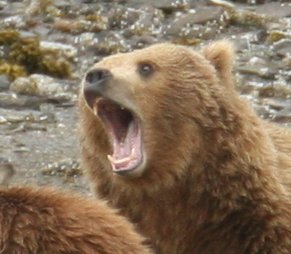
Copyright © 2007, P. Lutus. All rights reserved. Message Page
(double-click any word to see its definition)
In past articles, I have been a bit too revealing about where I go to watch bears, and I now see an increasing number of very aggressive, fast boats making brief appearances, just long enough to take some snapshots and scare the bears away. Typically a fast, noisy aluminum boat, filled with people armed with relatively simple camera equipment, will speed into a bay, race up to the nearest bear and proceed to snap some pictures. The boat driver moves close enough to accommodate the simplest camera, but this makes the bear very anxious. The bear will then leave the beach, at which point the boat moves on to the next available bear. In fifteen minutes, all the bears have left for the high country, then the boat leaves too.
The rationale is simple to state. The tourists are in a hurry and they don't have very good cameras, so they need to get close to the bears. Also they need to do this in a hurry (because there's a lot to see in very little time). So they hire the fastest boat, piloted by the most aggressive driver they can find. They drive right up to the bears, in the noisiest boats you can imagine.
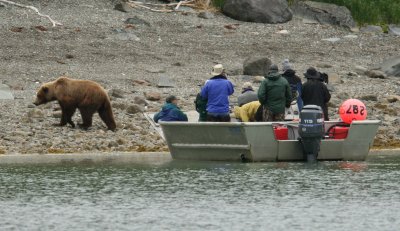
Driver, could you get a little closer?
|
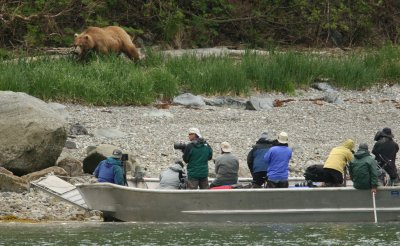
This bear is cornered and is looking for an escape path. Shortly after this, he sprinted off the beach.
|
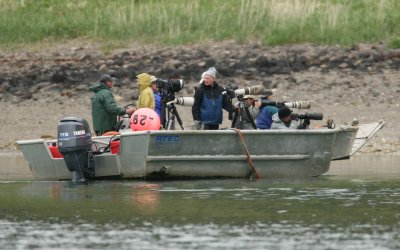
The boat moves on to another target, a mating pair.
|
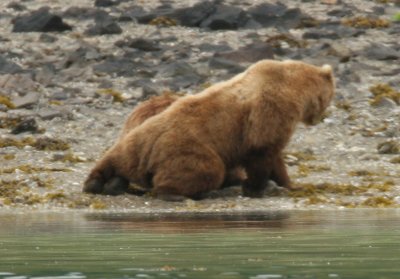
The boat is too close and the bears can't help but notice.
|
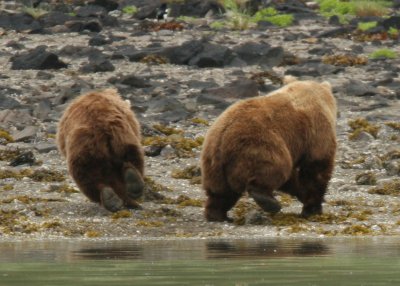
Normally, bears having sex are in another world for up to an hour, but these bears panic and run.
|
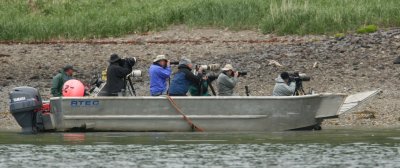
Keep snapping, boys. We don't have all day.
|
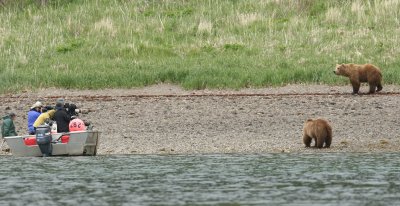
I've noticed these fast boats frighten male bears (background) much more than females (foreground). I assume this is because most male bears have been hunted at some point (although this location is part of a nature preserve, no guns allowed).
|
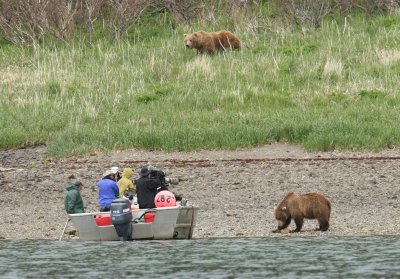
The male bear in the background is about to break and run. The female in the foreground seems entirely indifferent.
|
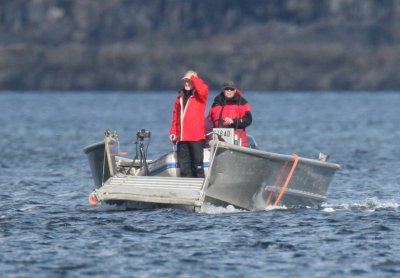
Another fast boat arrives. These people have something special in mind — they're going to land their boat and get out.
|
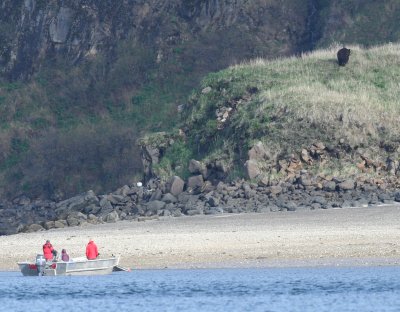
As the boat lands, Othello, the scariest, most aggressive bear I've seen in many years, temporarily abandons his territory.
|
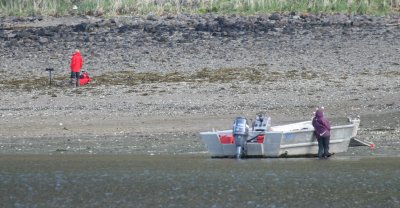
The tourists get out of the boat and occupy the beach, but they leave someone with the boat in case they have to make a quick exit.
|
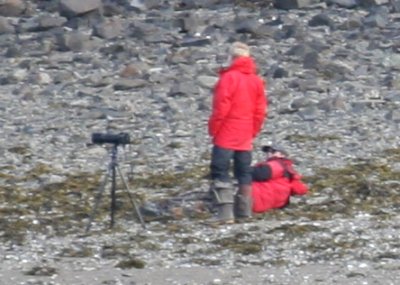
A closeup of the Timothy Treadwell wannabes.
|
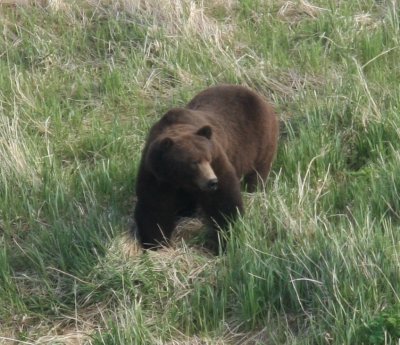
After about 15 minutes, Othello overcomes his fear and begins to stalk the intruders. From my position I can see Othello, and I can see the tourists, but Othello has chosen a position in the high grass where he can see without being seen. He slowly moves toward the men on the beach.
|
Discussion
On seeing Othello break cover and move toward them, the tourists left the beach and returned to their boat without incident. About an hour after the boat left, the bears overcame their fear and returned to the beach to dig clams and mate.
There are some bear distance rules in effect in this wildlife preserve. Basically, you need to stay 50 yards (about 46 meters) away from a single bear, or 100 yards (about 91 meters) from a female bear with cubs. It's sometimes difficult to judge distances in photographs and I think the fast boats followed the rules about 80% of the time, but they were certainly stressing the bears, who stopped whatever they were doing and left the beach. When you see bears stop having sex, break apart and run, you know they are stressed. The fast boats weren't merely observing the bears — they were driving them away.
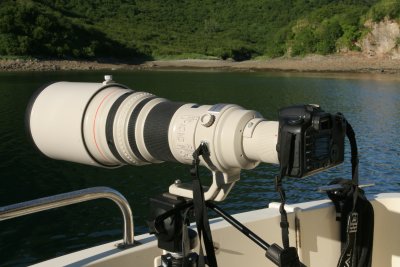
These boats are operated by commercial charter services, whose clients typically are people on vacation who don't have much time. They don't have particularly sophisticated cameras, so they need to get as close to the bears as possible. Also, there's a certain amount of pressure to get the bears to look directly at the camera — this makes the pictures more interesting. The problem is, when a bear looks directly at you, he is trying to decide whether to (1) run away or (2) have you for lunch.
Finally, there are visitors who won't be satisfied unless they can get out of the boat and walk around where the bears are. Remember this is a bear preserve, no guns or hunting allowed, with a large population of relatively fearless bears. The vocabulary of charter operators is not unlimited, but you can be sure it includes the expression, "Sure, what the hell, we can do that!"
When I go to one of these bear areas, I'm not in a hurry. I might stay five days in a single location. I drop my anchor well away from shore, turn off my engine and try not to make any noise for the remainder of my visit. I have a terrific telephoto lens that overcomes the problem of distance, so I don't need to drive up to the bears to get decent pictures. Bears tend to be nearsighted, and after I have been quietly at anchor for a few hours, the bears forget all about me. So I get pictures of bears acting naturally.
I don't mean to pretend. I'm also a tourist, and this entire discussion is about the degree to which someone intrudes into the bears' world.
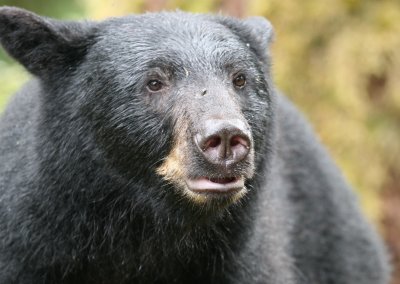
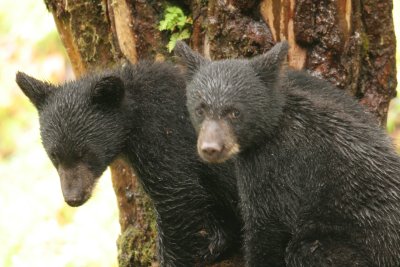
Cub-sitting
In any case, when visiting a bear environment, things get complicated at times. When I am in Southeast Alaska I sometimes hike to a salmon stream to watch the bears fish. This is a situation not at all like that described above — it's the height of a salmon run, there are plenty of fish, the bears are not hungry or stressed. I usually sit on a stump and take a few pictures. Sometimes a female bear with cubs will approach me, spend enough time at close range to decide I'm not a threat, then try to leave her cubs with me for safekeeping while she goes fishing. The logic is that the male bears, who would like to attack her cubs, are justly terrified of humans (see the pictures above for an example), so if mama bear can leave her cubs with a human, they'll be safe and she'll have more freedom of movement than she would with her cubs tagging along.
Bear-sitting is not something I volunteer for because of the obvious risks, but getting out of it can be riskier than letting it happen (because beating a hasty retreat may invite a bear's pursuit). I've talked to a number of photographers who've had similar experiences.
I've read a number of articles that say bears have tiny brains and are rather dumb. That is not my experience. I regularly see some pretty sophisticated bear reasoning, like mama bear deciding that I'm a safe haven for her cubs, on the basis that the male bears, the primary threat to her cubs, wouldn't think of approaching me.
But my perception of bear intelligence is related to my perception of human intelligence, and over decades I've gradually realized that some people are astonishingly dumb, given the size of our brains. I know my readers may find this hard to believe, but when people run out of reasonable arguments to support a decision they've made, they frequently abandon anything resembling rational thought and instead invoke the authority of an imaginary ruler of the universe. Over time, their ability to reason withers away like an unused limb, and they begin to invoke the authority of an imaginary superbeing all the time.
The advantages of this system should be obvious. Because the ruler of the universe is fictional, he won't contradict anyone who invokes his authority. In fact, people can and do justify absolutely anything based on this imaginary authority without any chance of contradiction. It's a kind of artificial, self-imposed stupidity, by creatures who aren't naturally stupid. It reverses the natural tendency to accomplish as much as possible with a little, and tries to accomplish as little as possible with a lot.
Such people, having permanently shut their brains down, possess no personal doubt whatever. They are supremely confident of the rightness of their thoughtless actions. This raises ordinary clinical narcissism to an art form and strips it of anything resembling caution or self-doubt. It turns out that about 90% of Americans can be relied on to invoke the imaginary authority when things become complicated and a keen, trained mind would ordinarily be called for.
By that measure, bears aren't dumb at all. At least they work things out for themselves, without abandoning the reasoning powers nature has granted them.
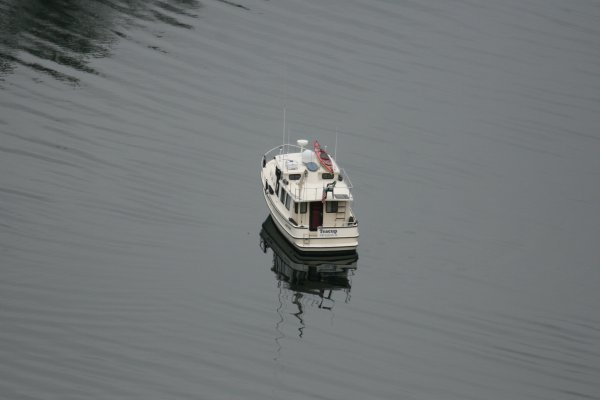
At anchor in a bear area.
|
| Home | | Sailing | | Alaska 2007 | |  |  |  Share This Page Share This Page |